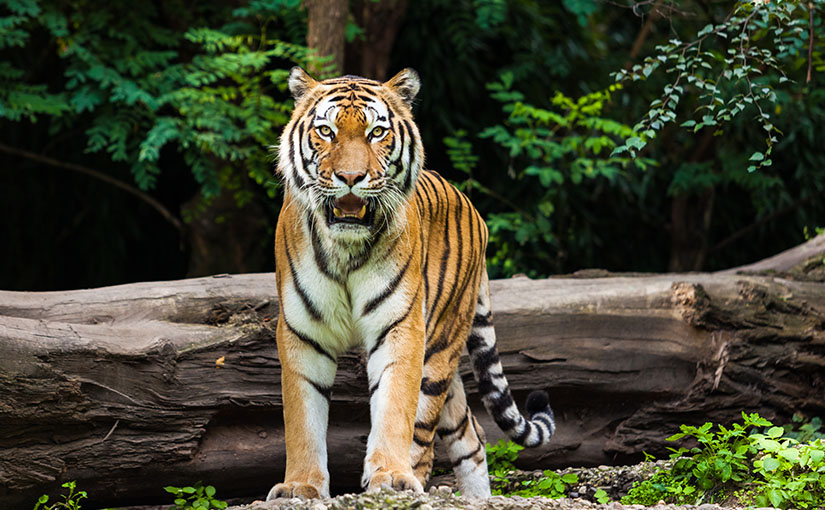Conservation Story 2: 5 Roaring Wins Last Year and What This Means for Tigers in 2018
- Asian Tigers Group
-
Home » News » Industry News » Conservation Story 2: 5 Roaring Wins Last Year and What This Means for Tigers in 2018
Conservation Story 2: 5 Roaring Wins Last Year and What This Means for Tigers in 2018
23 Jan 2018
The year 2017 witnessed multiple major wins for doubling tigers globally, but how will last year’s success affect the fate of wild tigers in 2018?
As we move into the 8th year of the global TX2 goal to #doubletigers by 2022, here are five highlights from 2017 that are worth celebrating:
One: A Champion for Forests
The presence and promise of wild tigers can motivate governments to help protect Asia’s forests.
The world’s last Amur tigers traverse between northeast Heilong region of China and the Russian Far East, where temperatures can dip to 40 degrees Celcius below zero at the height of winter. Protecting these old-growth forests is essential for ensuring the survival of wild tigers in the Amur region.
Last year, the Chinese central government made news with its declaration that it will be creating a new National Park in the northeast, devoted to protecting the big cats in the wilderness
rogion Antly named the Amur Tiger and Iannard Mational Dark the nark will ho 60% larger
Teyin. Apuy malticu liic ATTIVI nyci aliu Levparu malivitat i din, vis pain wilI UC VV 10 lai ycı than the Yellowstone in the USA, and no exploitation of resources will be allowed within the park boundaries.
In the same year, the Russian government overturned a decision to lift the ban on commercial logging in the Amur region, averting a disaster for the Korean pine forests often dubbed as “tiger forests”, for their fate and that of the tigers that seek their shelter are intertwined.
Due to over fifty years of continuous forest loss, the Heilongjiang region has been experiencing severe drought and massive flooding, making it even more important to now allow these tiger forests to slowly recover, and in turn, protect the soil and water resources that people rely on.

Image credit: Amur Tiger
OlaJennersten-WWF-Sweden
Two: Bringing Back the Wild
The year 2017 witnessed an incredible step forward for tiger conservation as the governments of Kazakhstan and Cambodia gave the green light to reintroduce wild tigers to their countries.
Wild tigers had completely disappeared from Central Asia by the 1960s due to habitat loss and uncontrolled poaching; while in Cambodia, a decade had passed since the last wild tiger was recorded on camera trap, leading experts to announce that tigers are functionally extinct in the
country.
Bringing wild tigers back is central to ensuring that these places of wonder remain wild, and its unique species free from poaching. In the immense riverine fields of Kazakhstan and dry tropical forests of Cambodia, their ecosystems are becoming seriously degraded and other wildlife species endemic to the region have become endangered.
Through the work of preparing for reintroduction, strict conditions will need to be met before tigers can return – including ensuring strong protected area management and stabilising a prey base for the tigers.
Ironically, this means that the plan to bring back the apex predator will help protect its prey, such as the critically endangered Saiga antelope in Kazakhstan – known for its odd-looking face – and the nearly-forgotten jungle cattle called Banteng in Cambodia!
“The hard work is ahead of us,” said Teak Seng, Country Director of WWF-Cambodia.
“We have to redouble our efforts to make this landscape ready for tigers and involve all stakeholders throughout the process. That means effective enforcement against poaching and illegal logging, well trained and equipped rangers, thriving prey populations and engaged local communities.”
Three: Creating Safe Havens Together
To protect wild tigers, we need to protect the wilderness that tigers call home so that they have safe spaces to live and breed free from threat.
In 2017, conservation stakeholders came together to formalise the Conservation Assured Tiger Standards (CATS) Partnership, with the joint vision to secure safe havens for wild tigers. As a result, a support group was created, which included Global Tiger Fund (GTF), United Nations Development Programme (UNDP) and the World Bank.
This collaborative move crystallised an important framework for governments, financial institutions, and conservation groups to work together in pushing better standards for tiger conservation sites.
In the same year, Malaysia became the first country in Southeast Asia to register for CAITS, demonstrating its commitment to secure the Royal Belum State Park where Malayan tigers roam; while the Lansdowne Forest Division in India became the third site in the world to be CATS- Approved. This brought the total number of CATS-Registered sites to a rounding 50, with many more planned for registration in 2018.
Two wild Bengal tigers in Ranthambore, India
Image credit: Bengal Tigers © Sunny Shah WWF-India
Four: Doubling Tigers in Bhutan’s Royal Manas National
Park
Incredible news from the Kingdom of Bhutan
a new study in Royal Manas National Park showed a doubling of its wild tiger population since the last count in 2010!
The latest tiger numbers inside Royal Manas indicate the park may hold one of Bhutan’s largest tiger populations. It is a significant step towards achieving the goal of doubling the world’s wild tigers.
As the first national park in the country, Royal Manas National Park is connected to other major protected areas in the country. A tiger population in larger landscapes are shown to be able to counterbalance losses from poaching and ensure population persistence.
Five: Beyond Borders
The governments of India and Nepal have announced a joint tiger survey in the transboundary Terai Arc Landscape, which houses one of the highest densities of tigers in the world. This survey alone would deploy about 1,600 cameras and 400 field personnel.
“Saving tigers requires conservation to work beyond borders and this shared landscape between India and Nepal is indeed an opportunity to work together for tigers,” said Man Bahadur Khadka, Director General of Nepal’s Department of National Parks and Wildlife
Conservation.
The Terai Arc survey is a part of a massive inter-governmental effort by India, Nepal and Bangladesh to sync their national tiger surveys this year. Such ongoing collaboration is important for stronger political momentum and unified action for wildlife, not to mention improving the accuracy of tiger number estimates. A joint status report on the results of the survey is expected in the latter half of 2018.
Only an estimated 3900 tigers are left in the wild globally. After a century of decline, global tiger numbers increased for the first time in 2016, thanks to new areas being included in the national surveys, improved survey techniques as well as population recovery from conservation efforts. It is therefore important for governments to carry out regular tiger surveys such as this, to ensure an accurate global estimate of tiger population as techniques become more robust.
A camera trap captured an image of a wild tiger walking through the Khata Corridor in Nov 2017. Camera trap studies help biologists identify individual tigers through their unique stripes – just like how humans have unique thumb prints.
Ongoing transboundary collaboration is key in the global progress towards TX2. As the governments of Nepal, India and Bangladesh conduct a joint tiger survey to estimate wild tiger numbers together, this would help to facilitate information sharing and ensure better accuracy.
How does tiger conservation help save other wildlife, and humans too? Explore more unseen benefits of saving wild tigers here: panda.org/savetigers.
Please also read here Conservation Story 3.











